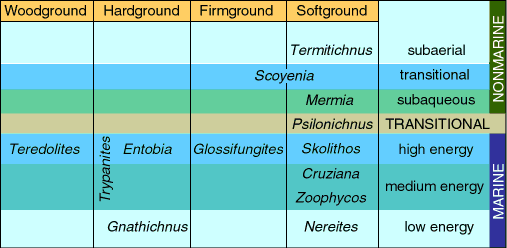


Kansas Geological Survey, Current Research in Earth Sciences, Bulletin 241,
part 1
Allostratigraphic and Sedimentologic Applications of Trace Fossils to the Study of Incised Estuarine Valleys--page 6 of 13

Conceptual Background of Ichnology
Trace fossils are biogenic sedimentary structures that reflect the behavior of their producers. As noted by Pemberton, Frey et al. (1992), trace fossils are both paleontologic and sedimentologic entities, and therefore they bridge the gap between these two fields of study. Trace fossils are used for the analysis of sedimentary successions in two different but sometimes complementary ways: the ichnofacies and ichnofabric approaches (cf., Bromley, 1996). An ichnofacies is a trace-fossil assemblage that recurs through geologic time and is characteristic of a given set of environmental conditions (Seilacher, 1967; Pemberton, Frey et al., 1992). Eleven archetypical ichnofacies have been formally proposed, the Termitichnus, Scoyenia, Mermia, Psilonichnus, Skolithos, Cruziana, Zoophycos, Nereites, Teredolites, Glossifungites, and Trypanites, the latter subdivided into the Entobia and Gnathichnus ichnofacies (Seilacher, 1967; Frey and Seilacher, 1980; Bromley et al., 1984; Frey and Pemberton, 1987; Bromley and Asgaard, 1993; Buatois and Mángano, 1995) (fig. 7). Ichnofabrics, on the other hand, comprise all aspects of the texture and internal structure of a sediment that result from bioturbation (Bromley and Ekdale, 1986). As such, they include both the identifiable and unidentifiable biogenic structures (Bottjer and Droser, 1991). Bedding-plane trace fossils, however, commonly are overlooked in ichnofabric analysis (but see Miller and Smail, 1997).

Fig. 7. Archetypical ichnofacies and their characteristic environments (adapted from Pemberton, Frey et al., 1992).
Ichnology of Incised Estuarine Valleys
A typical vertical succession of ichnofacies is commonly associated with estuarine valley incision and subsequent infill (Pattison, 1992; Ranger and Pemberton, 1992; MacEachern et al., 1992; Pemberton, Reinson et al., 1992; MacEachern and Pemberton, 1994). Open-marine, highstand, progradational parasequence sets that underlie estuarine deposits typically contain a high-diversity Cruziana ichnofacies, reflecting the work of an equilibrium community developed under fully marine conditions (MacEachern and Pemberton, 1994). Such open-marine deposits are truncated by a discontinuity surface caused by incision during a sea-level fall and subsequent transgressive erosion (coplanar surface). This discomformity typically hosts the Glossifungites ichnofacies, which records colonization in a firmground substrate associated with erosional exhumation (MacEachern et al., 1992). MacEachern and Pemberton (1994) noted that where basal fluvial lowstand deposits separate the sequence boundary from the initial flooding surface, the Glossifungites ichnofacies is absent. Under lowstand conditions, this ichnofacies is only present at the seaward end of the estuarine valley (MacEachern et al., 1992). Valley-fill deposits overlying the coplanar surface accumulate during the subsequent transgression and sea-level highstand and contain an impoverished ichnofauna characterized by a mixture of the Skolithos and Cruziana ichnofacies (Pemberton and Wightman, 1992; Pemberton, Reinson et al., 1992; MacEachern and Pemberton, 1994). This depauperate ichnofauna records the activity of an opportunistic community developed under stressful conditions in a brackish-water estuarine setting. According to Wightman et al. (1987) and Pemberton and Wightman (1992), brackish, marginal-marine trace-fossil assemblages are characterized by (1) low diversity, (2) forms typically found in marine environments, (3) the dominance of infaunal traces rather than epifaunal trails, (4) simple structures produced by trophic generalists, (5) a mixture of vertical and horizontal traces from the Skolithos and Cruziana ichnofacies, (6) the abundance of a few forms, and (7) the presence of monospecific suites. Brackish assemblages may be replaced vertically by high-diversity, open-marine assemblages of the Cruziana ichnofacies associated with the termination of estuarine deposition by a major flooding event (Pemberton, Reinson et al., 1992). In other cases, the ichnologic record of the valley fill is more complex where the estuarine system varies repeatedly between brackish and fully marine conditions (e.g., MacEachern and Pemberton, 1994). In “compound” valley systems, highly diverse equilibrium and depauperate opportunistic trace-fossil assemblages tend to alternate.

Kansas Geological Survey
Web version March 19, 1998
http://www.kgs.ku.edu/Current/1998/buatois/buatois6.html
email:lbrosius@kgs.ku.edu